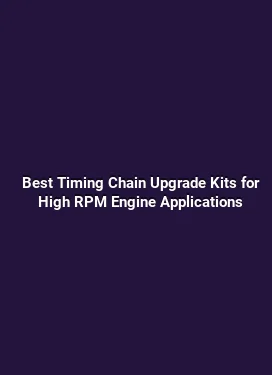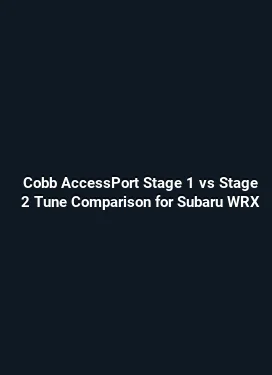How to Install Flex Fuel Sensor for Automatic E85 Tune Switching
Modern engines equipped with flex fuel capability rely on accurate fuel composition data to adapt fueling and timing dynamically. A flex fuel sensor (FFS) provides real-time ethanol content information, enabling an electronic control unit (ECU) to switch to an appropriate tune for E85, ethanol blends, or gasoline. This article dives into the practical steps, from selecting a sensor to wiring, calibration, and field-tested tuning approaches. It emphasizes reliability, repeatability, and safety while presenting actionable tips that enthusiasts can apply in their own builds.
Foundations of Flex Fuel Sensing and Automatic E85 Tuning

At the heart of automatic E85 tuning is a sensor that measures the ethanol content of the incoming fuel. Ethanol content directly affects stoichiometry, ignition timing, and fueling duty cycles. The goal is to provide the ECU with a precise percentage of ethanol in the blend, typically ranging from pure gasoline (0% ethanol) to E85 (around 51–85% depending on region and fuel quality). The sensor data allows the ECU to select a corresponding fuel map, ignition strategy, and boost targets (in forced-induction applications) that preserve performance while avoiding detonation or lean conditions.
The installation process is not merely about wiring a sensor to the ECU. It requires understanding fuel system dynamics, fuel line routing, pressure stability, and sensor health over time. Inconsistent readings can lead to poor mixture control, reduced power, or drivability issues. Therefore, the integration must consider the sensor’s response time, temperature compensation, and fault handling to maintain safe operation across all operating conditions.
Sensor Fundamentals and System Integration

Flex fuel sensors typically employ a robust electrochemical or capacitance-based sensing element. The sensor outputs a voltage or digital signal proportional to the ethanol percentage, which is interpreted by the ECU as a fuel composition input. In practical terms, this means a carefully designed wiring harness, shielded signal lines, and proper ground references are essential to minimize noise and ensure repeatable readings under vibration and varying temperatures.
Integration into the fuel system should consider the following: signal integrity, regulator stability, and the ECU’s ability to handle fault states gracefully. It is common to include a diagnostic routine that confirms the sensor is responding within expected ranges and that any anomaly triggers a safe fallback. The fallback could be a fixed baseline map that preserves drivability while alerting the operator to a sensor fault.
Choosing the Right Flex Fuel Sensor and Ancillary Components
Selection starts with compatibility with the vehicle’s fuel system, the intended operating environment, and the ECU’s data input capabilities. A high-quality sensor with appropriate thread size, pressure rating, and temperature tolerance reduces the risk of leaks and drift. Look for sensors with robust housings, EMI shielding for the signal wires, and a proven calibration method. In addition to the sensor, a dedicated harness kit, weatherproof connectors, and a shielded ground path contribute to long-term reliability.
Ancillary components include a surge-protected power supply for the sensor, a stable ground reference, and a filtering strategy to minimize electromagnetic interference from pumps, relays, and injectors. An inline filter can help prevent particulates or contaminants from affecting sensor readings in systems where the fuel is stored for extended periods or experiences temperature cycling. Pairing the sensor with a compatible ECU calibration file or flash that supports dynamic blend switching is essential for achieving smooth transitions between gasoline and ethanol-rich tunes.
Tools, Materials, and Safety Considerations
The installation process benefits from a well-equipped workbench. Essential tools include: wrenches for fuel line fittings, thread sealant appropriate for fuel systems, a multimeter with current and resistance measurement, and a data-logging device or software to monitor ethanol readings in real time. Safety is paramount when working with high-pressure fuel systems. Always relieve fuel pressure before disconnecting lines, work in a well-ventilated area, wear eye protection and gloves, and use fuel-compatible wipes for cleanup. A secondary containment plan is advisable in case of spills, and ensure no ignition sources are present during the procedure.
Materials to consider include a high-quality braided fuel hose or steel line compatible with ethanol blends, anti-corrosion fittings, a mounting bracket that minimizes stress on the sensor, and a weatherproof grommet for edge-protected cables passing through firewall or body panels. Documentation from the sensor manufacturer on torque specifications and calibration steps should be reviewed before starting the installation.
Physical Installation: Route, Mount, and Connect
Proper routing of the sensor is critical. The sensor should be placed where the fuel mixture is homogeneous and before any fuel pressure regulator or post-pump filtering that could introduce phase lag in readings. A common approach is to install the sensor in the return line or near the primary rail where the blend is consistent. The mounting location should minimize vibration and heat exposure while maintaining easy access for future service or calibration checks.
When mounting, ensure the sensor orientation allows any venting or drain paths to remain unobstructed. Use clamps or brackets that distribute load evenly and avoid twisting the sensor cable. Route signal lines away from high-current paths (injector wiring, fuel pump power) to reduce electrical noise. Ground and shield the signal wires at a single point to prevent ground loops, and verify continuity from the sensor to the ECU with the engine off and the battery disconnected for safety checks.
Electrical connections must be made with weatherproof connectors. Seal unused pins to prevent moisture ingress and corrosion. After wiring is complete, perform a continuity check and inspect for any pin misalignment that could lead to erroneous readings or ECU faults. If the setup uses a digital data link, verify the baud rate and data integrity through a controlled test drive in a safe environment before road use.
Wiring Architecture and Calibration Strategy
A clean wiring schema includes a dedicated power supply to the sensor, a stable reference ground, and a shielded signal line to the ECU. Some installations benefit from a miniature regulator to supply the sensor with a constant voltage, independent of battery fluctuations. The calibration strategy involves three phases: baseline validation with known fuel blends, dynamic testing across typical driving scenarios, and long-term drift assessment. The goal is to establish a repeatable mapping from sensor output to ethanol content that the ECU can rely on for seamless tune switching.
Calibration steps commonly include: running the vehicle on gasoline to capture baseline readings, then introducing E10 or E85 under controlled conditions to record sensor output. It is important to perform calibration at ambient temperatures that reflect typical operating environments, as ethanol content readings can drift with temperature. Data logging should capture engine load, RPM, manifold pressure, air-fuel ratio, ignition timing, and the sensor reading concurrently to build a robust map that the ECU can interpolate during real-world driving.
ECU Mapping and Automatic Tune Switching Without Venturing into Risky Territory
The ECU’s interpretation of ethanol data must drive safe and predictable behavior. Automatic tuning logic should prioritize reliability and drivability over maximum power in uncertain conditions. A three-tier approach is often effective: a conservative gasoline map for low ethanol content, a blended map for mid-level ethanol blends, and a fully boosted or higher-traction map for high ethanol content where performance gains justify the risk. The transition between maps should be smooth, with interpolation algorithms that prevent abrupt changes in fueling or timing that could surprise the driver or surge components unnecessarily.
To ensure consistent results, incorporate fault handling protocols. If the sensor reading falls outside expected ranges or fails to respond within a predefined window, the system should revert to a safe default map. Visual indicators or data logs should communicate the fault to the operator, while the vehicle remains operable with the gasoline map until maintenance is performed. This strategy minimizes the chance of drivability issues during sensor downtime or maintenance cycles.
Real-world field tests emphasize repeatability. Take multiple cold and hot starts, idle and load conditions, and highway cruising into account. Verify that requested fuel trims align with recorded ethanol readings, adjust calibration coefficients as necessary, and confirm that the system responds within a few engine cycles to blend changes. In turbocharged applications, verify that boost control remains stable across ethanol transitions, as ethanol-rich blends can influence compressor efficiency and air density readings.
Diagnostics and Troubleshooting
When diagnosing issues, start with a baseline sensor check: ensure the sensor reports plausible ethanol values at known fuel blends. Check wiring for continuity, insulation integrity, and shielding. Inspect connectors for corrosion or water ingress. If readings are erratic, test with a known-good harness or substitute sensor temporarily to isolate the fault. Log data during a test drive to identify patterns that may indicate electrical noise, sensor heating, or endurance-related drift.
Common fault scenarios include sluggish response at cold start, sensor saturation during high ethanol content, and occasional misreads under high vibration. Remedies range from re-routing signal wires to minimize interference, adding ferrite beads on the harness, to replacing aged connectors. Regular maintenance, including cleaning the fuel system and checking for fuel varnish buildup, can improve sensor longevity and performance consistency.
Operational Best Practices and Real-World Examples
Proactive tuning practice combines data-driven logging with conservative safety margins. Start with modest calibration tweaks that emphasize drivability and fuel economy before chasing peak power. In daily driving, the seamlessness of the sensor-driven transition is noticeable when the vehicle automatically adapts to ethanol-containing fuels without hesitation or abrupt changes in acceleration. For enthusiasts who push toward track days or high-load scenarios, consider supplemental safeguards such as gradual ramp rates for fuel adjustments and tighter fault thresholds to protect the engine from detonation under high ethanol content.
In a practical setup, a mid-tier street car with a turbocharged engine uses a flex fuel sensor to switch between an efficient gasoline map and a more aggressive ethanol map as ethanol blends rise above a threshold. The ECU adapts timing and fueling, while a separate data logger records ethanol content, air-fuel ratios, and ignition timing. This approach delivers consistent performance across fuels while maintaining reliability for street use and occasional track sessions. Regularly revisiting calibration after fuel quality changes or intercooler upgrades helps sustain optimum performance and fuel economy.
Trend-conscious tuners often incorporate adaptive learning curves into the calibration file. This means the system gradually refines the blend-handling map based on real-world feedback—learning from average operating conditions rather than relying solely on static tables. The result is better long-term stability and smoother transitions, even as fuel quality or ambient temperatures shift between seasons.
Maintenance planning should include periodic sensor health checks, wiring inspection, and software version reviews. A clear maintenance log helps track calibration changes, sensor replacements, and observed performance shifts. Keeping a repository of data from various driving conditions also supports future tuning decisions and helps diagnose reliability concerns without guessing outcomes.
Conclusion-Free Readability and Practical Takeaways
Installing a flex fuel sensor for automatic E85 tune switching is a multi-faceted task that blends mechanical routing, electrical integrity, and strategic calibration. The key lies in ensuring accurate, repeatable readings, robust fault handling, and a carefully staged ECU map that preserves drivability while leveraging ethanol’s performance potential. The approach outlined here emphasizes reliability, field-tested procedures, and practical troubleshooting without compromising safety or engine health. With meticulous attention to routing, shielding, calibration, and ongoing validation, a flex fuel-enabled setup can deliver seamless, real-world gains across a wide range of fuels and driving conditions.
As fuel blends continue to evolve and regional availability changes, maintaining a disciplined calibration process and a proactive maintenance routine will help sustain performance and reliability. The result is a flexible, responsive engine management solution that harmonizes fuel chemistry with intelligent tuning strategies, enabling enthusiasts to unlock the full potential of their builds while keeping protection at the forefront.






